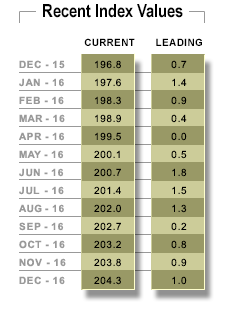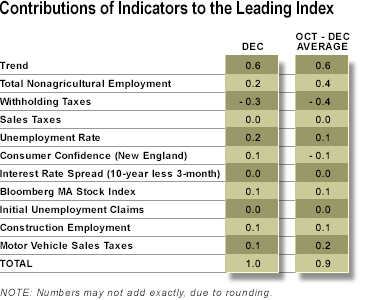State economy appears to slow in the 4th quarter
Expected federal fiscal policy may provide boost in 2017; labor supply a major constraint.
December 2016
 Massachusetts real gross domestic product grew at an estimated annual rate of 0.5 percent in the fourth quarter of 2016 according to the MassBenchmarks Current Economic Index. Nationally, real gross domestic product grew at an estimated 1.9 percent during the same period. MassBenchmarks, the journal of the Massachusetts economy, is published by the UMass Donahue Institute in collaboration with the Federal Reserve Bank of Boston. Based on the latest available data, MassBenchmarks now estimates that the state's economy expanded at a 3.1 percent rate in the third quarter. The Bureau of Economic Analysis estimates that the state grew by 1.7 percent in the second quarter, and contracted by 1.9 percent in the first quarter, while the U.S. grew by 3.5 percent in the third quarter, 1.4 percent in the second quarter and 0.8 percent in the first quarter.
Massachusetts real gross domestic product grew at an estimated annual rate of 0.5 percent in the fourth quarter of 2016 according to the MassBenchmarks Current Economic Index. Nationally, real gross domestic product grew at an estimated 1.9 percent during the same period. MassBenchmarks, the journal of the Massachusetts economy, is published by the UMass Donahue Institute in collaboration with the Federal Reserve Bank of Boston. Based on the latest available data, MassBenchmarks now estimates that the state's economy expanded at a 3.1 percent rate in the third quarter. The Bureau of Economic Analysis estimates that the state grew by 1.7 percent in the second quarter, and contracted by 1.9 percent in the first quarter, while the U.S. grew by 3.5 percent in the third quarter, 1.4 percent in the second quarter and 0.8 percent in the first quarter.
Economic growth in Massachusetts appears to have decelerated in the fourth quarter to a more pronounced degree than was the case nationally. This may reflect tighter labor force capacity constraints in the state as unemployment rates are very low, indicating very little slack in the labor market which may be making it difficult for some employers to fill open positions. Wage and salary incomes also appeared to decline in the fourth quarter after experiencing strong growth earlier in the year. Indicators of spending by households and businesses remained strong during the final quarter of 2016.
The unemployment rate for Massachusetts residents declined to 2.8 percent in December from 3.6 percent in September and 4.9 percent one year ago. It is now well below the pre-recession low of 4.6 percent in 2007. Even the state's broader U-6 measure, which includes involuntary part-time workers and those who want a job but haven't searched in the last four weeks is near pre-recession levels. In December, the broadest definition of state unemployment stood at 7.4 percent, close to the prerecession low of 7.1 percent in September 2007.1
These rates are significantly lower than the national headline unemployment rate, which stood at 4.7 percent in December. The national U-6 rate was 9.2 percent in December. While some slack remains, the available labor supply may not be well matched with the requirements of expanding Bay State employers. This may help to explain why payroll employment in Massachusetts grew at a 0.9 percent rate in the fourth quarter after expanding at a 2.4 percent pace in the third. U.S. employment grew 1.4 percent in the fourth quarter and 1.8 percent in the third quarter respectively.
 "While wage and salary income declined at a 7.6 percent rate in the fourth quarter, this is surprising but doesn't necessarily indicate falling labor incomes," noted Alan Clayton-Matthews, MassBenchmarks Senior Contributing Editor and Associate Professor of Economics and Public Policy at Northeastern University, who compiles and analyzes the Current and Leading Indexes. This measure is estimated from withholding tax revenues, and can fluctuate from quarter to quarter for many reasons. "One reason for the slowdown in income growth may be strong income growth in the third quarter (11.8 percent) which, according to the Massachusetts Department of Revenue, was affected by one-time business tax events that effectively shifted some income receipts into the third quarter from the fourth quarter," Clayton-Matthews added.
"While wage and salary income declined at a 7.6 percent rate in the fourth quarter, this is surprising but doesn't necessarily indicate falling labor incomes," noted Alan Clayton-Matthews, MassBenchmarks Senior Contributing Editor and Associate Professor of Economics and Public Policy at Northeastern University, who compiles and analyzes the Current and Leading Indexes. This measure is estimated from withholding tax revenues, and can fluctuate from quarter to quarter for many reasons. "One reason for the slowdown in income growth may be strong income growth in the third quarter (11.8 percent) which, according to the Massachusetts Department of Revenue, was affected by one-time business tax events that effectively shifted some income receipts into the third quarter from the fourth quarter," Clayton-Matthews added.
The fourth quarter is also the season for bonuses, and the timing of their receipt can make fourth quarter estimates volatile. With a new administration in Washington D.C. and uncertainties about changes in federal income tax rates, the timing of receipt of bonus payments may have been delayed.
Consumer and business spending on items subject to the state regular sales tax expanded at a 10.3 percent rate in the fourth quarter, after falling at 0.7 percent rate in the third quarter. Sales were strong for both items subject to the regular sales tax and for motor vehicles. Relative to the fourth quarter of 2015, this measure of spending was up 2.2 percent.
The MassBenchmarks Leading Economic Index suggests that the state economy will continue to grow at this subdued pace over the next six months, at 0.9 percent in the first quarter of this year, and 1.0 percent in the second quarter. Aside from effects in stock market prices — which to this date are positive but not large — the leading index is not capturing the expectations of many economists of a fiscal stimulus that may most boost growth later this year or in 2018. Even though there are still worries about Europe and China, slow but steady world economic growth is expected for this year. There are probably more upside than downside risks to the relatively slow outlook suggested by the leading index. However, labor supply constraints will almost certainly become more of a drag on growth as time goes on and the retirements of baby boomers increase.
 The 10 indicators that comprise the leading index usually do not all move in tandem. Typically, some may indicate an expectation of faster than average growth, while at the same time others may indicate an expectation of slower than average growth. The following table accounts for the contributions of each towards faster or slower growth than the recent underlying trend of 0.6 percent. The index value is their sum.
The 10 indicators that comprise the leading index usually do not all move in tandem. Typically, some may indicate an expectation of faster than average growth, while at the same time others may indicate an expectation of slower than average growth. The following table accounts for the contributions of each towards faster or slower growth than the recent underlying trend of 0.6 percent. The index value is their sum.
In December, six indicators contributed to a forecast of above-trend growth: total nonagricultural employment, the unemployment rate, consumer confidence, the Bloomberg stock index for Massachusetts, construction employment, and motor vehicle sales taxes. Three indicators contributed to average-trend growth: sales taxes, the interest rate spread between 10-year and 3-month U.S. Treasury securities, and initial unemployment claims. One indicator, withholding taxes, contributed to below-trend growth.
In the three-month period October through December, five indicators contributed to a forecast of above-trend growth: total nonagricultural employment, the unemployment rate, the Bloomberg stock index for Massachusetts, construction employment, and motor vehicle sales taxes. Three indicators contributed to average-trend growth: sales taxes, the interest rate spread between 10-year and 3-month U.S. Treasury securities, and initial unemployment claims. Two indicators contributed to below-trend growth: withholding taxes, and consumer confidence.
 The current and historical quarterly estimates for state domestic product growth include adjustments for changes in productivity growth. These adjustments are estimates of the quarterly deviations from the 1978-2015 trend in the growth of the ratio of output to employment. In the fourth quarter of 2016, these adjustments subtracted 1.6 percentage points from growth. In the third quarter of 2016 these adjustments subtracted 0.3 percentage points from growth. In the second quarter of 2016, these adjustments subtracted 1.9 percentage points from growth. In the first quarter, these adjustments subtracted 3.1 percentage points from growth. For the forecast of state domestic product growth in the first and second quarters of this year, productivity growth is assumed to be at the average of the last five years.
The current and historical quarterly estimates for state domestic product growth include adjustments for changes in productivity growth. These adjustments are estimates of the quarterly deviations from the 1978-2015 trend in the growth of the ratio of output to employment. In the fourth quarter of 2016, these adjustments subtracted 1.6 percentage points from growth. In the third quarter of 2016 these adjustments subtracted 0.3 percentage points from growth. In the second quarter of 2016, these adjustments subtracted 1.9 percentage points from growth. In the first quarter, these adjustments subtracted 3.1 percentage points from growth. For the forecast of state domestic product growth in the first and second quarters of this year, productivity growth is assumed to be at the average of the last five years.
Several recent months of the indices are revised each release. These revisions are a result of the statistical method used to create the index, as well as revisions in the underlying indicators.
1.) The U.S. Bureau of Labor Statistics does not release the U-6 monthly at the state level. MassBenchmarks obtains monthly estimates directly from the Current Population Survey. The figures reported here are seasonally-adjusted and smoothed to make them comparable to the monthly U.S. rates.
--------
All of the indicators except interest rates refer to Massachusetts. The current index is composed of four indicators: nonagricultural employment, withholding taxes, sales taxes, and the unemployment rate. The leading index includes these four current indicators plus the other six (leading) indicators in the contributions table. All of the indicators are as of December, except for interest rates and the Bloomberg stock index for Massachusetts, which are through January 20. The MassInsight Consumer Confidence Index is released every third month. Intervening months are interpolated, and changes in the Conference Board's Consumer Confidence Index for the U.S. are used to extrapolate to the current month of the index, as needed. Series measured in current dollars or values, i.e., withholding taxes, sales taxes, the Bloomberg stock index, and motor vehicle sales taxes, are deflated by the U.S. consumer price index for all urban consumers, excluding food and energy.
For a description of the methodology used to construct these indices, see:
Alan Clayton-Matthews and James H. Stock, "An application of the Stock/Watson index methodology to the Massachusetts economy," Journal of Economic and Social Measurement, vol. 25 (1998/1999), pp. 183-233.
Dr. Alan Clayton-Matthews
MassBenchmarks
Northeastern University, School of Public Policy and Urban Affairs
January 27, 2017

